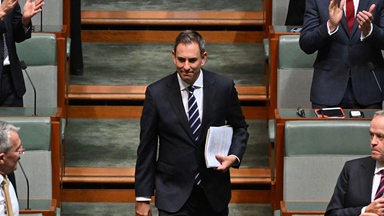Loading component...
At a glance
High commodity prices and a strong labour market have delivered stronger revenues and enabled the Federal Government to post the first budget surplus in 15 years while also funding key programs and cost-of-living relief.
Federal Treasurer Dr Jim Chalmers’ second budget forecasts a surplus of $4.2 billion – or 0.2 per cent of GDP – in 2022-23, an improvement of $41.1 billion on last year’s October budget.
Since October, tax receipts have been revised upwards by $67.2 billion, while the Treasurer has reprioritised $17.8 billion in spending by the previous government.
The surplus is expected to only be transitory, however, with the budget falling back to a $13.9 billion deficit next year, followed by further deficits across the forward years.
Chalmers says that overall, this would lead to a $125.9 billion improvement in government finances over five years, with the deficit peaking lower and earlier at $36.6 billion in 2025-26, $154 billion less than was expected in March 2022.
CPA Australia media release
Lacking in long-term vision

While saying the budget struck the right balance between cost-of-living relief and limiting inflation, CPA Australia Senior Manager Business and Investment Policy Gavan Ord calls the budget “prudent but lacking in long-term vision”.
“Overall, we’re pleased with the prudent approach to tackling economic challenges. The government has shown admirable restraint on spending in the Federal Budget,” says Ord.
“Unfortunately, we’re still missing a long-term plan that drives a sustainable and economically certain future for Australia. This was billed as a ‘two-part’ budget to get us back on track and ready to move forward. The government has tackled current challenges but failed to reach for economic opportunities.”
Ord also notes a lack of significant support for small business.
“The government now needs to evolve its thinking from providing support to growing productivity,” he says.
“A clear strategy provides businesses the confidence they need to invest and prepare for the future. We need a detailed plan to allow all businesses to prepare for significant change.”
Australia’s economic growth to slow
Despite the stronger budgetary position, Dr Chalmers says that the “next two years are expected to be the weakest for global growth in over two decades.”
“This will affect us here in Australia,” he adds.
The impact would be that Australian economic growth was forecast to slow from 3.25 per cent in 2022-23 to 1.5 per cent the year after, before recovering to 2.25 per cent.
Inflation was expected to fall from 6 per cent this year to 3.25 per cent next year and return to the Reserve Bank’s 2 to 3 per cent target range in 2024-25.
The unemployment forecast is for a modest rise to 4.25 per cent by the June quarter and 4.5 per cent by June 2025.
Wages growth for 2023-24 is now forecast at 4 per cent, up 0.25 per cent on what was expected in October.
“This combination of lower-than-expected inflation and higher wages means that an earlier and stronger return to real wages growth is forecast for 2023-24,” says Chalmers.
Cost-of-living measures are welcome

The improved fiscal position has enabled the government to fund a raft of new measures, such as a $14.6 billion cost-of-living plan comprising help with power bills and health costs. There is also a $40 per fortnight increase in JobSeeker, Youth Allowance, Austudy and other income support payments.
Recipients of the Single Parenting Payment will receive the payment until their youngest child turns 14, up from eight.
The maximum rate of the Commonwealth Rent Assistance program will be raised by 15 per cent – or up to $31 a fortnight – from September this year, costing the government $2.7 billion over five years.
Budget 2023 also allocates $3.5 billion to boost bulk billing of health services, which should give more people greater access to free visits to GPs.
Eligible households and small businesses will receive targeted electricity bill relief of up to $500 for households and $650 for small businesses. Eligible households will include pensioners, Commonwealth Seniors Health Card holders and Family Tax Benefit A and B recipients.
In aged care, the additional funding is for the workforce, with $11.3 billion earmarked to fund a 15 per cent increase in award wages for 250,000 aged care workers.
Not enough for small business

The budget includes a one-year instant asset write off for businesses with an annual turnover of under $10 million. Such businesses can write off the full cost of eligible assets costing less than $20,000 purchased in 2023-24.
The asset must be first used or installed ready for use between July 1 this year and June 30, 2024, but the $20,000 is less than the $150,000 limit and $500 million turnover threshold introduced as part of the pandemic stimulus.
The budget also includes a one-year Small Business Energy Incentive to support investments in power-saving assets such as more efficient fridges, battery systems, heat pumps and electric heating and cooling.
“Small and medium businesses, with aggregated annual turnover of less than $50 million, will be able to deduct an additional 20 per cent of the cost of eligible depreciating assets that support electrification and more efficient use of energy,” according to details in the budget papers.
"Up to $100,000 of total expenditure will be eligible for the Small Business Energy Incentive, with the maximum bonus deduction being $20,000."
This measure will apply to eligible investments first used or installed ready for use between July 1 this year and 30 June 2024.
Revenue raising ahead

At the same time, businesses can expect greater scrutiny from the Australian Taxation Office (ATO), which will receive just under $600 million over four years to boost resources to promote GST compliance. This additional funding will also be used to help the ATO develop more sophisticated analytical tools to combat emerging risks to GST collections.
This funding is expected to reap another $3.8 billion in tax receipts over the four years.
The budget also includes some revenue-raising measures, such as the previously announced plan to tighten superannuation concessions for people with balances of $3 million or more.
Smokers have also been hit, with tobacco taxes up by 5 per cent for the next three years.
There is also a 15 per cent global and domestic minimum tax for large multinational companies, and changes to the Petroleum Resources Rent Tax, which is expected to raise $2.4 billion over the next four years.
“The global minimum tax rules would allow Australia to apply a top-up tax on a resident multinational parent or subsidiary company where the group's income is taxed below 15 per cent overseas.”
That measure is expected to net $370 million over the five years from 2022-23.

